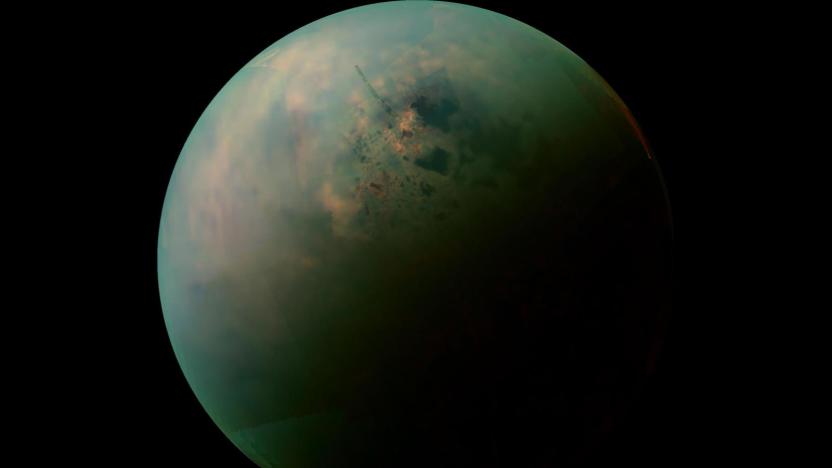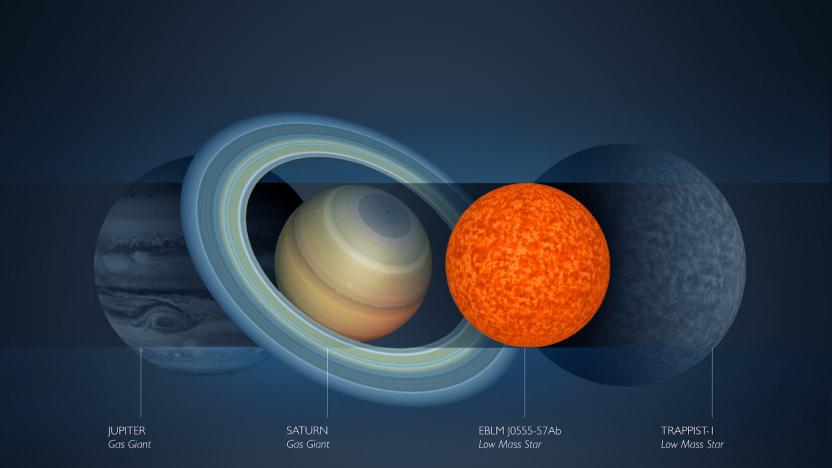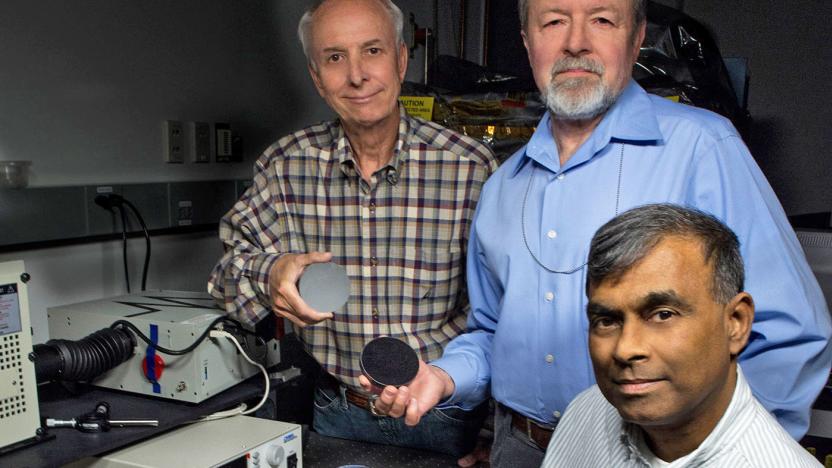telescope
Latest

New computer models could direct scientists to epic cosmic events
Now that they're spotting gravitational waves more often, scientists are expanding their search for cosmic events. Specifically, they're using new computer models to depict the cataclysmic collision that occurs when a black hole joins a neutron star (the remnants of an exploded star). The simulations will help detectors track down the actual mergers using telescopes and advanced versions of LIGO (the Laser Interferometer Gravitational-Wave Observatory).

Lockheed Martin previews a future of tiny space telescopes
Current space telescopes are... big. You can't really avoid it given the need for giant lenses and bulky sensors. Lockheed Martin wants to fix that -- the aerospace firm has just released the first images from SPIDER (Segmented Planar Imaging Detector for Electro-Optical Reconnaissance), an optical instrument that promises pictures as sharp as what you'd get from a space telescope in a sensor that's just an inch thick. Instead of using a handful of monolithic lenses, it relies on a legion of small lenses whose data is divided and recombined using a photonic circuit. The initial results aren't spectacular, but they hold a lot of promise.

A molecule found on Saturn's moon Titan could foster life
In a new study published today in Science Advances, researchers report that they've found a complex molecule in the atmosphere of Saturn's moon Titan that could lead to the formation of life. Cell membranes are the outer barrier of most cells found on Earth and they, or structures like them, are crucial for life to form. And while Titan is quite different from our planet, it's thought that this molecule -- vinyl cyanide -- is one that could potentially form cell membranes in the Titan environment.

Astronomers spot the smallest star so far
Researchers at the University of Cambridge have found the smallest star ever discovered. It's just slightly bigger than Saturn and while its mass is similar to that of TRAPPIST-1 -- which NASA recently found seven Earth-sized planets rotating around -- its radius is 30 percent smaller.

Researcher uses Game Boy Camera to capture 2-bit photos of space
The Game Boy Camera, released in 1998, wasn't even close to the weirdest peripheral for Nintendo's classic handheld console and even earned a Guinness World Record for the smallest digital camera in the world. Its 2-bit, 128 x 128 pixel CMOS sensor managed very grainy black-and-white shots, making it far more fun than technically impressive. And yet, a Dutch researcher and tinkerer just used one to catch some charmingly blocky photos of the moon and Jupiter.

ESA’s search for Earth’s ‘twin’ starts in 2026
The European Space Agency (ESA) announced today that it is officially adopting the PLATO mission. PLATO, which stands for PLAnetary Transits and Oscillations of stars, is a planet-hunting project that will look for Earth twins -- planets just like our own.

Astronomers prove Einstein right: Stars can warp light
In a new study published today in Science, researchers achieved a rare event -- simultaneously proving Albert Einstein both right and wrong. The scientists were able to confirm one of Einstein's theories, something even he wasn't sure would be possible.

Construction starts on the world's largest optical telescope
After several years of planning and no shortage of financial anxiety, construction has officially started on the Extremely Large Telescope. Contractors are now building the main structure and dome of the Chile-based observer ahead of its initial service in 2024. That's a long time to wait, but this is no mean feat. With a 43-yard aperture, this promises to be the world's largest optical telescope for sometime, even compared to future or in-limbo projects like the Thirty Meter Telescope. Those gigantic dimensions will help it capture far more light, giving astronomers the chance to spot particularly distant galaxies, find small planets and capture more details of larger planets.

Pay for your next pizza without ever leaving Telegram
The latest update to messaging app Telegram has added a couple of welcome features to the platform that presents itself as a secure alternative to WhatsApp. The first enables users to record minute-long videos to send to one another instead of having to type out their feelings using boring old words. Telegram is boasting that sending these clips will be much faster than other services, since the video is compressed and transmitted while you record.

ESO will upgrade its Very Large Telescope to hunt for exoplanets
The European Southern Observatory's Very Large Telescope is getting an upgrade. ESO signed an agreement with Breakthrough Initiatives, a program created to search for extraterrestrial intelligence, to modify its infrared instrument called VISIR (VLT Imager and Spectrometer for mid-Infrared). Once it's done, the observatory in the Atacama Desert of northern Chile will easily be able to spot exoplanets in the Alpha Centauri. According to ESO, the astronomers' discovery of a habitable planet in our neighboring star system late last year "adds even further impetus to this search."

ICYMI: Read your dog's mood swings with tech
try{document.getElementById("aol-cms-player-1").style.display="none";}catch(e){}Today on In Case You Missed It: A new product out of Japan called Inupathy is giving dogs the Dug treatment, with a light up harness that tracks their heart rate, telling you information about their emotions via changes in color. We've no idea if it works as advertised, but you gotta admit the rainbow pattern signaling 'happy' is the most human expression for happiness in animals we could ever think of. Obviously your dog won't know what it means, since the silly loves are color blind.

ICYMI: Orbital space junk is putting us in jeopardy
try{document.getElementById("aol-cms-player-1").style.display="none";}catch(e){}Today on In Case You Missed It: The US Air Force is moving its Space Surveillance Telescope to Australia to track space junk littering geosynchronous orbit. That's the orbit 22,000 miles away from our planet where satellites mirror the Earth's rotation so that they don't appear to move. The Department of Justice story about facial recognition is here, while that darling sneezing baby (who eschews costumes) is here. If you enjoy the cartoon humor that is an engine giving up on a job, that's here. As always, please share any interesting tech or science videos you find by using the #ICYMI hashtag on Twitter for @mskerryd.

NASA extends the Spitzer mission for two-and-a-half years
When the Spitzer telescope blasted off to space on August 25th, 2003, NASA didn't think it would still be doing science by 2016. But since it's alive and well 13 years later, the agency has granted it a two-and-a-half-year mission extension to make discoveries the astronomers "never imagined exploring with the spacecraft." The space telescope's next stage officially called the "Beyond phase" will begin on October 1st this year. It represents a period in the elderly spacecraft's life fraught with engineering challenges due to its age.

NASA is making a small carbon nanotube telescope for CubeSats
A team of NASA Goddard scientists are developing a lightweight and low-cost telescope small enough to fit inside CubeSats. Those mini satellites provide the agency an inexpensive means to send various experiments to outer space. By creating a small telescope sensitive to ultraviolet, visible and infrared wavelength bands that can fit inside a CubeSat, NASA will be able to explore space for cheap. Obviously, the images it sends back won't be as high-res as the photos taken by Hubble or by one of the humongous ground-based telescopes. However, the team says it could be a great "exploratory tool for quick looks that could lead to larger missions." It will also likely be the first one to use the new carbon nanotube mirror the team designed.

Telescopes catch the aftermath of a black hole swallowing a star
Astronomers have observed a supermassive black hole swallowing a star 3.9 billion light years from Earth. The group used the European VLBI (Very Long Baseline Interferometry) network of telescopes, so big it's described as "Earth-sized", to observe the phenomenon.

China finished the world's largest single-aperture telescope
For the past 53 years, Puerto Rico's Arecibo Observatory has been the king of radio telescopes. No more. China has just finished construction of its Five hundred meter Aperture Spherical Telescope (FAST), which is 64-percent larger. That makes it the worlds largest single-aperture telescope -- the world's largest radio telescope is Russia's RATAN-600, which has a sparsely filled aperture.

NASA tasks the Hubble Telescope with five more years of service
Despite its successor launching in 2018, NASA is extending duty for the Hubble Space Telescope for another five years. The imaging spacecraft will continue to capture breathtaking photos from orbit until 2021 with the Space Telescope Science Institute in Baltimore. The final servicing mission to the telescope took place in 2009, and now it's set to provide images from our solar system and beyond into the next decade.

The Arecibo radio telescope is in trouble again
Unfortunately, the Arecibo Observatory's iconic radio telescope is facing an uncertain future once again... and there's only a short amount of time for you to have a say in its fate. The National Science Foundation is considering a number of options for the space-centric facility, including either putting its operations in the hands of partners or shutting it down entirely. It's holding public meetings today (June 7th) and accepting written comments until June 23rd to discuss the "environmental impact" of its options, but there's a good chance that the conversation will revolve around the telescope's survival.

NASA and Germany extend the life of their flying observatory
SOFIA, the airborne telescope that backed up New Horizons in studying Pluto, will go on flights to observe our universe until the end of 2020. NASA and the German Aerospace Center (Deutsches Zentrum für Luft- und Raumfahrt or DLR) have extended their joint project for four more years. SOFIA is a 17-ton infrared telescope with an 8.9-foot-diameter primary mirror fitted into a Boeing 747SP wide-body plane. A hatch on the aircraft slides open so the telescope can get a view of the sky. And since it operates at altitudes of about 41,000 feet, it can make its observations above most of the water vapor in the Earth's atmosphere, which blocks some infrared waves.

Watch a 450-year-old supernova continue to bloom
Back in 1572, a white dwarf's explosion shone brightly on the sky. It was visible to the naked eye, and astronomers like Tycho Brahe were able to monitor the event despite not having the equipment we do today. We might have missed the chance to see what's now known as Tycho's supernova, but thanks to Chandra X-ray observatory's data, we can see its remnant continue to bloom almost 450 years later. A group of astronomers compiled Chandra's observations from the year 2000 to 2015 to create a video showing its ongoing expansion.








